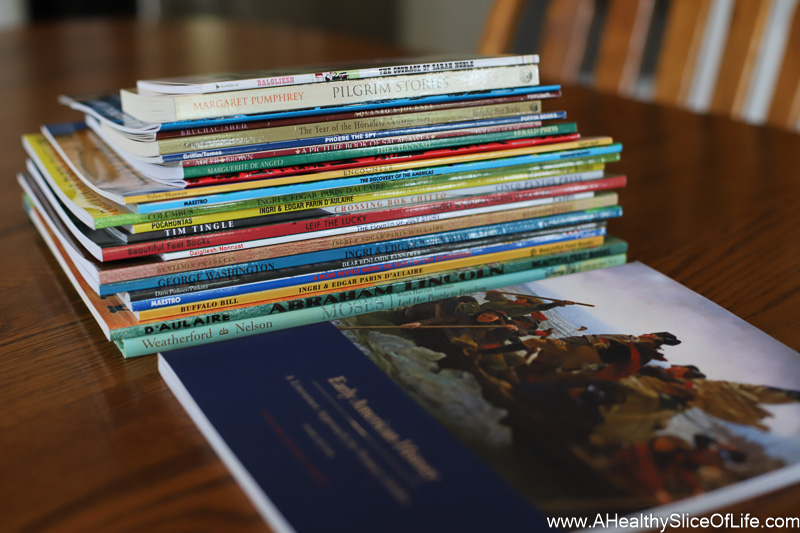This post has been a long time coming, as we have been using Beautiful Feet’s Early American History for over a year now. You can get through it in a year’s time, but we all enjoy it so much, we opted to stretch it out, allowing ourselves to dive deeper into the events we find fascinating, and venturing down the rabbit holes of additional books and videos.
If you are new to Beautiful Feet, let me introduce you to why it’s our favorite part of our curriculum.
Beautiful Feet offers literary-based curriculum for kindergarten all the way through 12th grade. They believe strongly that we are born with an innate desire to learn through the power of story and offer Charlotte Mason inspired history and literature curriculum.

Since we have used Beautiful Feet Around the World curriculum (see that detailed review here), Around the World Part 2 curriculum, and Early American History curriculum, I can vouch for the “sticking” power of this method.
My girls remember the Yangtze River in China thanks to the story Ping. They love to tell people that contrary to popular belief, the Vikings (see detail on the Viking unit here) were actually the first Europeans to land in America, and so on and so forth.
It’s been great to watch history come to life before us through living books and we’ve had great discussions thanks to the multiple viewpoints the curriculum presents the material through.
See all our homeschool curriculum picks and posts here.
Five Reasons We Love Beautiful Feet Early American History
- The teacher’s guide is simply and beautifully designed. There is no confusion on how to run each lesson. It provides clear directions, discussion questions, and extras if you so choose, like related youtube videos, books, songs, and more.
- The lessons are what I call “bite-sized,” usually taking no more than 20 minutes if sticking the basic lesson. Primary (K-3) level is designed to do 2-3 lessons a week.
- The books used are engaging and offer differing perspectives on historic events (such as the Native American’s view on the European settlers). Even the chapter books with no pictures (that I was somewhat worried about for my 7 year old) ended up being huge hits, as each lesson broke the book into digestible units.
- The Historic Table at the end of each unit highlights cuisine and includes recipes that would have been common to the people and time frame we are studying. For us food lovers, this makes a really fun way to dive deeper into a unit and really connect to the time period. We use this as a “celebration” before we move onto the next unit and it’s always so much fun.
- Purchasing the Primary Pack comes with everything you need. Every book, every print out, the journal, the teacher’s guide- everything. I love that I’m never searching for supplies or not ready for a lesson. Plus the books are so good that they’ve become favorites on our book shelves to go back to, even long after the unit has ended.



Kelli says
I’m digging deeper into the world of homeschooling so thank you for always sharing your curriculum. I remember you had Kaitlyn in a preschool before switching her to
Homeschool. I have Camryn in a Pre K class currently and now I’m thinking of switching her when she starts kindergarten. I’m a little worried she won’t want to switch since she seems to really like her school.
Brittany Dixon says
I remember being SO nervous about starting H is kindergarten after preschool (especially because K was still in the preschool she loved so much and I thought she’d be so bummed about being left out). And I won’t lie, seeing everyone else get geared up for sending their kids to kindergarten also messed with my emotions. I made sure we had a special first week set up (reading and treat at a bakery and things like that). However, it was more in my head than Hailey’s. She missed parts of preschool but we started creating our own world with friend dates and field trips and nature walks and science experiments and she loved it. I think since we know what to expect more than they do, we worry more about them “missing out.”
A plus, though, is that the number of homeschoolers has exploded in recent years and I only see that growing, so it’s been so much easier to find playgroups, co-ops, adventure groups, friends, etc. Good luck figuring out the best fit for yall, and I’m always happy to answer questions if I can be helpful! 🙂
Meaghan says
To save money, do you think purchasing the teachers guide and sourcing the books from the local library as needed would work out okay? I will have a first grader and kindergartener next year. I am trying to decide what to do for science and social studies. Would you hold off on these till my kids are a little older? I’ve heard such good things about Beautiful Feet but the price tag has me nervous for my young kids.
Brittany Dixon says
You definitely could for some of the books, but I don’t believe they are all available at the library. They’ve started adding in some of their own published books. The good news is the books are all wonderful and make a great addition to the family library for years, but you are right; the cost is significant. Do you have a friend that also might be interested in using this program and you could split it? One of you do it one year than switch? I’ve shared my set with friends and it’s worked really well!
Kelly says
What did you do next? I’m only seeing early Americans history?
Brittany Dixon says
We did Around the World Parts 1 and 2, Early American History, and now are doing the US Georgraphy.